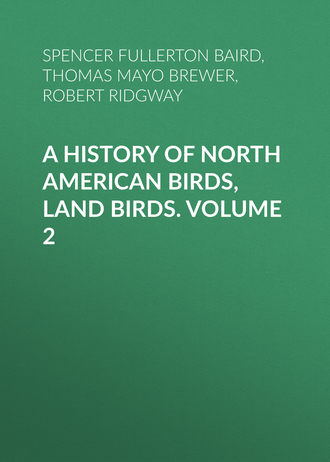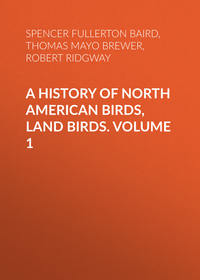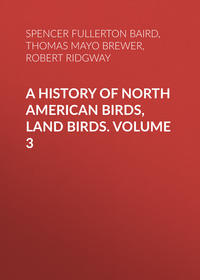 полная версия
полная версияПолная версия
A History of North American Birds, Land Birds. Volume 2
116
Selasphorus (platycercus, var. ?) flammula (Salv.). Selasphorus flammula, Salvin, P. Z. S. 1864 (Costa Rica). (Described above from specimen in Mr. Lawrence’s collection.)
117
Selasphorus (rufus var. ?) scintilla (Gould). Selasphorus scintilla, Gould, P. Z. S. 1850, 162, Monog. Troch. III, pl. cxxxviii. The foregoing species are so similar in all essential respects to the northern S. platycercus and S. rufus, that it is exceedingly probable that they are merely the southern forms of those species. Both differ in exactly the same respects from their northern representatives, namely, in smaller size and less burnished throat, and to a very slight degree only in form. The only specimen of the S. flammula that we have examined is a badly shot male in Mr. Lawrence’s collection; what appears to be the outer primary in this specimen is not attenuated at the tip, which is curved inward, instead of acutely attenuated and turned outward as in platycercus; the wings are badly cut with shot, however, and the first primary may be wanting.
118
Heliopædica melanotis, (Swains.) Gould, Monog. Troch. II, pl. lxiv. Trochilus melanotus, Swains. Phil. Mag. 1827, 441. Trochilus leucotis, Vieill. Ornismyia arsenni, Less. Hab. Mexico and Guatemala.
119
Am. Naturalist, 1869-70.
120
Geococcyx affinis, Hartlaub, Rev. Zoöl. 1844, 215.—Bonap. 97.—Scl. P. Z. S. 1858, 305.—Sclater & Salvin, Ibis, 1859, 134.—Sclater, Catal. 1862, 325. Geococcyx velox, Karw. Bonap. 97.
121
Coccygus melanocoryphus, Vieillot, Nouv. Dict. VIII, 271.—Sclater, Catal. 1862, 323.—Ib. P. Z. S. 1864, 122.
122
Crotophaga major, Linn. Syst. Nat. I, 363.—Max. Beitr. IV, 319.—Scl. Cat. 1862, 320. C. ani, Vieill. Gal. Ois. II, 35, pl. xliii.
123
Crotophaga sulcirostris, Swainson, Phil. Mag. 1827, I, 440.—Bonap. Consp. 89.—Scl. P. Z. S. 1856, 309, 1859, pp. 59, 368, 388, et 1860, pp. 285, 297.—Ib. Catal. 1862, 320. C. casasi, Less. Voy. Coq. Zoöl. I, pl. ii, 619, et Cent. Zoöl. pl. ix.
124
Conspectus avium picinarum. Stockholm, 1866.
125
A character common to all the members of the genus, and distinguishing them from the species of every other; this peculiar form of the middle tail-feathers is caused principally by a folding of the webs downward, almost against each other. The under surfaces of the shafts have a very deep groove their whole length, which is seen in no other genus.
126
Campephilus bairdi, Cassin, Pr. A. N. Sc. 1863, 322 (Cuba).—Gundlach, Repertorium, I, 1866, 293.—Ib. Cab. Jour. 1866, 352. Hab. Cuba.
127
Picoides tridactylus, var. tridactylus. Picus tridactylus, Linn. S. N. 12th ed. I, 177 (1766).—Degland, Orn. Eur. I, 161 (1849). Apternus tridactylus, Bonap. Birds (1838), p. 9.—Gould, Birds of Europe pl. ccxxxii. Picoides tridactylus, Gray. Picoides europæus, Less. Orn. p. 217 (1831).
128
Picoides tridactylus, var. crissoleucus. Picus crissoleucus, Brandt, Mus. Petrop. Apternus crissoleucus, Bonap. Consp.—Reich. Syn. p. 362, No. 836; pl. dcxxxi, f. 4197, 4198. Picoides crissoleucus, Malh. Monog. Pic. I, 180. “Apternus kamtchatkensis, Bonap.”—Malh. Monog. Pic. I, 180 (in synonomy). Apternus tridactylus, Mus. de Mayence.—Pallas, Zoogr. Ros. As. I, 415.
129
Centurus carolinus, var. tricolor. Picus tricolor, Wagl. Isis, 1829, 512. Centurus tri. Scl. Catal. Am. B. 1862, 343. C. subelegans, Scl. P. Z. S. 1855, 162; 1856, 143.
130
Centurus aurifrons, var. hoffmanni. Centurus hoffmanni, Cabanis, Journ. Sept. 1862, 322 (Costa Rica).
131
Melanerpes formicivorus, var. striatipectus, Ridgway. In view of the very appreciable difference from the other races named, it appears necessary to name this one, in order that it may rank equally with the rest. The almost entirely streaked breast is only an approach to what we see, in its extreme phase, in the var. flavigula. The black vertex of the female appears broader than in specimens of var. formicivorus.
132
Melanerpes formicivorus, var. flavigula, Natt. Melampicus flavigula (Natt.), Malh. Rev. Zoöl. 1849, 542, Monog. Pic. II, 202, pl. xcix, f. 5, 6. Melanerpes flavigularis, Scl. P. Z. S. 1856, 161. This can only be considered the melanistic extreme of a species of which the var. formicivorus is the rubescent one, the transition being gradual through the var. striatipectus of the intermediate region.
133
Colaptes mexicanoides, Lafr. Rev. Zoöl. 1844, 42.—Scl. & Salv. Ibis, 1859, 137.—Scl. Catal. Am. B. 1862, 344. Colaptes rubricatus, Gray, Gen. B. pl. cxi. Geopicus rub. Malh. Monog. Pic. II, 265, pl. cx, figs. 1, 2. Picus submexicanus, Sund. Consp. Pic. 1866, 72.
134
A series of hybrids between mexicanus and auratus is in the Smithsonian collection, these specimens exhibiting every possible combination of the characters of the two.
135
Colaptes auratus, var. chrysocaulosus. Colaptes chrysocaulosus, Gundlach, Boston Journal.—Ib. Repert. I, 1866, 294.
136
Die Papageien. Monographisch bearbeitet von Otto Finsch. 2 vols. Leiden, 1867, 1868.
137
A. Tail longer than the wings; lores and cheeks naked; the latter with narrow lines of small feathers.
S. militaris. Green; forehead red; posterior portion of back, upper and under tail-coverts with quills and tip of tail, sky-blue; under side of tail dirty orange-yellow. Wing, 14.00; middle tail-feathers, 15.00; tarsus, 1.08. Hab. Northwestern Mexico to Bolivia.
Synonymy: Psittacus militaris, Linn. S. N. 1767, 139. Sittace militaris, Finsch, Die Papageien, I, 1867, 396.
B. Tail about equal to the wings; lores and cheeks feathered.
S. pachyrhyncha. Green; the forehead, edge of wings, and the tibiæ red; greater under wing-coverts yellow. Wing, 8.00 to 10.00; middle tail-feather, 6.50. Hab. Southern Mexico (Jalapa and Angangueo), given probably erroneously from the Rio Grande of Texas. Synonymy: Macrocercus pachyrhynchus, Sw. Syn. Birds Mex. in Philos. Mag. I, 1827, 439, No. 79. Rhynchopsitta pachyrhyncha, Bon. Tableau des Perroquets, Rev. et Mag. de Zoöl. 1854, 149. Sittace pachyrhyncha, Finsch, Die Papageien, I, 1867, 428. Psittacus pascha, Wagler, Isis, 1831, 524. Psittacus strenuus, Licht. Preis-Verzeichiss, 1830.





